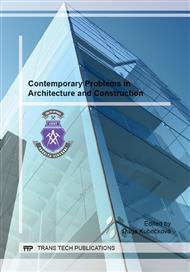p.9
p.15
p.21
p.25
p.31
p.37
p.43
p.49
p.55
Exploration Results of Applying Limestone Powder in Crushed-Stone-Sand Mixtures for Road Pavement Layers
Abstract:
This paper presents results of exploration related to C2 and C6 crushed-stone-and-sand ready mixtures strengthened with limestone powder used in road pavement layers. Limestone powder is an industrial waste, which in Ararat region is in big volumes. The samples were taken composed of different fractions of crushed-stone and two types of sand produced from crushed basalt and crushed gravel, and were tested. The composition of ready mixtures meets the requirements of corresponding standard on grain size. To these mixtures limestone powder was added of the percentage range 0-30% of the mixture mass. The main purposes of experimental exploration were to determine the influence of different percentages of limestone powder on compression strength of crushed-stone-and-sand ready mixtures and optimal content of powder. The change of the influence grade was studied by applying different types of sands. Three cylindrical samples were made for each percentage of limestone powder according to a standard method. Compressive strengths of samples have been determined. It was concluded, that the applying limestone powder in C2 and C6 ready mixtures contributes to the cohesion of stone grains as well as to obtaining high indicators of compaction in road pavement layers. The received results allow to arrive to a conclusion that applying limestone powder according to the optimal range distinctly increases the strength characteristics of crushed-stone-sand ready mixtures which in tur contributes the effective implementation of the compacting process. Especially the influence grade is considerable in C6 ready mixtures containing a large amount of crushed stone, as well as in mixtures using sands with smaller fineness modulus.
Info:
Periodical:
Pages:
31-36
Citation:
Online since:
October 2014
Authors:
Keywords:
Price:
Сopyright:
© 2014 Trans Tech Publications Ltd. All Rights Reserved
Share:
Citation:


